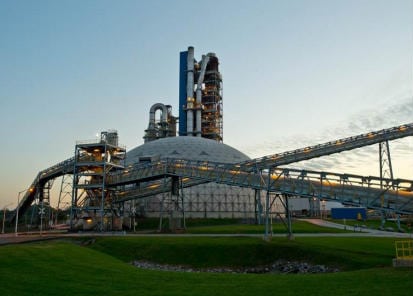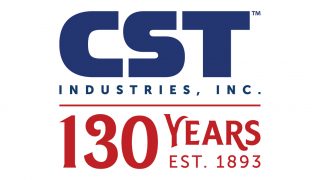The Martinsburg plant is unusual in a number of ways. Located on the outskirts of Martinsburg the plant has a strong relationship with the local community. When other facilities were closing their doors or postponing expansion projects, the Martinsburg cement plant  invested over US$500 million in a massive upgrade and expansion that brought capacity up to 1.8 million t of cement. Although cement plants typically don’t set the bar for aesthetics, this plant fits nicely into the community, providing good jobs to go along with its good looks.
invested over US$500 million in a massive upgrade and expansion that brought capacity up to 1.8 million t of cement. Although cement plants typically don’t set the bar for aesthetics, this plant fits nicely into the community, providing good jobs to go along with its good looks.
Prior to expansion, the Martinsburg plant – previously owned by Capitol Cement – operated three wet kilns for a total capacity of 650 000 tpa of clinker. Its acquisition in 2002 by Essroc Cement Corporation provided the necessary financial and technical backing to upgrade and, in April 2006, ground-breaking and preparation activities began under the supervision of Italcementi’s CTG (Group Technical Centre). Though the American economy and cement demand nose-dived in the following years, work on the project continued and was completed in October 2009.
Plant overview
Martinsburg’s onsite quarry has sufficient raw material reserves for more than 50 years. Raw materials are crushed in the quarry using a 1200 tph 3-phase Hazemag stationary impact crusher type PMH 2025E/GSK. Iron ore, bottom ash and silica are brought in by truck. From the quarry, limestone is transported to CST Covers’ (formerly Temcor-Conservatek) raw material aluminum storage dome via a 405m long belt conveyor from ONT. The raw material is transported to four feeding silos before being fed to a 6200 hp LM 60.6 VRM from Loesche.
The 5-stage preheater/precalciner, together with the kiln and burner, were all supplied by FLSmidth. The preheater tower is 500 ft. tall and required special permission due to potential interference with flight patterns at the nearby Eastern West Virginia regional airport. The kiln is 62 m long on two supports and is powered by a friction drive system totaling 800 kW across two Rotax drives on rubber support for autoalignment. The kiln is fired by an FLSmidth Duoflex burner pipe and monitored by a Thermoteknix kiln scanner and thermal imaging system. Refractories were originally supplied by Refratechnik and installed using a Bricking Solutions brick rig and ramp; more recently old refractory has been replaced with Refracta bricks. The plant currently uses coal as its main fuel source but is considering alternative fuel use in the future. A recently installed rail link opens the plant up to cheaper coal imports from the local area. Coal is ground in a 550 kW Loesche LM 23.2 D vertical mill.
The cooler is an SF 4 x 6 crossbar cooler from FLSmidth. Clinker storage is in two separate silos according to clinker type: some 35% of the plant’s production is low-alkali cement. From the cooler, clinker is transported via a conveyor belt to two 5400 hp Loesche LM 53.3+3 VRMs for finish grinding, and then on to the silo storage system. The silos were supplied by Claudius Peters, which also added a 10 000 t cement silo in the plant expansion and redesigned the input and extraction of the existing east and central bank silos. Packing is via a Haver & Boecker rotary packer operating at 2000 bags per hour; the palletiser was supplied by Beumer. The majority of the plant’s product is shipped in bulk to markets including nearby Washington DC and Baltimore, and as far away as Columbus, Ohio.
Throughout, the plant uses a Honeywell control system. Eaton handled the installation and design of the electrical system; WEG supplied the motors and Cutler-Hammer provided the switches. Online analysis is conducted by Iteca Socadei systems.
Text courtesy of World Cement
www.worldcement.com
Benefits of CST Covers Aluminum Domes and Vaults:
- Corrosion Resistance—Aluminum oxidizes quickly to create a hard natural protective layer. It will last the lifetime of the structure and will not need to be re-painted for protection from the elements.
- Low Lifetime Maintenance Cost—Aluminum domes have little-to-no maintenance requirements over their lifecycle.
- Use in Any Climate—Aluminum maintains its strength through extreme climates. From the heat of the Middle Eastern desert, to typhoon winds of the Pacific, to snow loads in Antarctica, CST Covers domes are built to perform.
- Smelted (Uniform) Metal—Aluminum’s structural properties are not altered in the manufacturing or installation process.
- Clear-Span Capability—Aluminum’s lightweight characteristics allow for larger clear-spans than structures utilizing steel, concrete and other materials.
- Design Flexibility—Aluminum’s excellent strength to- weight ratio and creative component designs yield cost effective structural solutions for any application.
- High Reflectivity/Low Emissivity—Aluminum does not allow external conditions to influence the process or product inside, unlike steel. The result is more stable & constant interior conditions.
Contact Information:
CST Industries, Inc.
844-44-TANKS
sales@cstindustries.com

